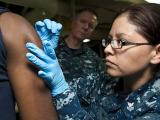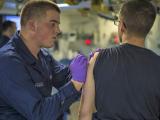Apr 29, 2005 (CIDRAP News) – In a recent study, some laboratory and public health workers who received smallpox shots reported several side effects that have not shown up in other studies, including joint and abdominal pain, backache, and breathing difficulty.
The side effects were reported by both first-time vaccinees and previously vaccinated workers but were more common in the first-time vaccinees, according to the report by James Baggs and colleagues at the Centers for Disease Control and Prevention (CDC) in Atlanta.
"As with recently described cardiac adverse events [following smallpox shots], our unexpected findings of increased proportions of subjects with joint pain, abdominal pain, backache, and difficulty breathing are suggestive of systemic involvement and warrant further study," says the report, published in the Apr 15 issue of Clinical Infectious Diseases.
However, none of the reactions were severe, and they all cleared up within a few weeks after vaccination, according to the report.
The study involved 1,006 laboratory and CDC workers who were immunized with conventional smallpox vaccine (Dryvax) in 2001 and 2002. Most were lab workers doing research in which vaccinia virus—the main ingredient in smallpox vaccine—was used as a vector. The vaccinees were given diary cards and asked to record any symptoms each day for 28 days after vaccination.
Three slightly different diary cards were used during the study period. Only the first version had a question about vaccination history. For participants who used the two later versions, the investigators used a roster of smallpox vaccinees to determine vaccination history.
Of the 1,006 diary cards, 936 (93%) were returned, the report says. Forty-seven percent of the respondents were older than 40, while 37% were between 31 and 40 and 26% were between 18 and 30. None of the workers reported severe reactions, and almost all the reported symptoms had disappeared by the end of 4 weeks. Itching at the vaccination site was the most common reaction, reported by more than 80% of the vaccinees.
Eleven symptoms were significantly more common in primary vaccinees than in those previously vaccinated. These included three of the unexpected symptoms: joint pain (25% vs 11%), abdominal pain (11% vs 2%), and backache (17% vs 7%). The other symptoms for which the two groups differed significantly were muscle pain (46% vs 19%), fatigue (43% vs 29%), swelling at the vaccination site (58% vs 33%), itching on the body (31% vs 17%), swollen or tender lymph nodes (71% vs 33%), pain at the injection site (48% vs 30%), headache (40% vs 25%), and fever of at least 100ºF (20% vs 9%).
Primary vaccinees had higher rates of several other symptoms as well, but the differences were not significant. The symptoms and respective rates were breathing difficulty (4% vs 1%), itching at the injection site (92% vs 84%), cough (11% vs 7%), loss of appetite (14% vs 8%), and chills (19% vs 12%).
By age-group, vaccinees 18 to 30 years were significantly more likely than those in the two older groups (31 to 40 and over 40) to report most symptoms, including joint and abdominal pain, backache, and breathing difficulty. Age and vaccination history were strongly related, as 88% of the youngest group had not been vaccinated before, versus 21% of the middle group and 2% of the oldest group.
Previous studies of smallpox vaccination have generally shown higher rates of side effects in primary vaccinees than in revaccinees. But three of the authors told CIDRAP News that the findings concerning joint, abdominal, and back pain and difficult breathing were unexpected on two counts: because they hadn't been reported in previous studies and because of the significant differences between primary vaccinees and revaccinees.
However, the investigators said previous studies did not look for these specific symptoms, as far as they knew, and added, "This study is one of only a few to describe mild to moderate symptoms following smallpox vaccination especially in a population with both primary and revaccinees." Authors Baggs, Robert Chen, and Gina Mootrey made the comments via e-mail.
The report says that breathing difficulty was not reported as a side effect in a 2002 study by Sharon Frey and colleagues of the effects of diluted and undiluted Dryvax in 665 previously unvaccinated young adults. The current study collected data "about a slightly different set of adverse events" than Frey and colleagues did, and consequently it documented "a broader range of systemic side effects," the article says.
The proportion of vaccinees who reported nausea in the 2002 study was about the same as the proportion reporting abdominal pain in the present study. The latter did not specifically ask for information about nausea, though three people reported it in a space for comments.
"Those who reported abdominal pain and/or difficulty breathing were more likely to report a number of other symptoms, suggesting these symptoms were part of a larger clinical syndrome and not a reporting artifact," the researchers write.
One limitation of the study, the article says, is that self-reporting with diary cards may have made participants more likely to report symptoms than they would have been otherwise. In addition, the lack of vaccination history information for some participants, along with the high correlation of age with vaccination status, meant there was some potential for confounding.
However, the study findings, combined with risk factors in today's population, "suggest that development of safer vaccines should be pursued and further expansion of pre-event smallpox vaccination should be done cautiously," the article concludes.
In their e-mail, the authors noted that some research on safer smallpox vaccines is under way. The British firm Acambis is testing modified vaccinia Ankara (MVA), a weakened form of smallpox vaccine, under a contract with the Department of Health and Human Services. The company has completed a phase 1 trial with 22 patients and plans to start phase 2 trials, in which adverse events will be closely watched, the authors reported. (Bavarian Nordic A/S of Denmark also has a federal contract to develop and test an MVA vaccine.)
The three authors said one other study, being conducted by the Department of Defense and the CDC's Clinical Immunization Safety Assessment Network, could also look for systemic reactions to smallpox vaccination. But that trial is "primarily a cardiac study looking at systemic markers of inflammation," they said.
Baggs J, Chen RT, Damon IK, et al. Safety profile of smallpox vaccine: insights from the laboratory worker smallpox vaccination program. Clin Infect Dis 2005 Apr 15;40(8):1133-40 [Full text]
See also:
Frey SE, Couch RB, Tacket CO, et al. Clinical responses to undiluted and diluted smallpox vaccine. N Engl J Med 2002 Apr 25;346(17):1265-74 [Full text]
CDC information on normal reactions to smallpox vaccine
http://www.bt.cdc.gov/training/smallpoxvaccine/reactions/normal.html


















